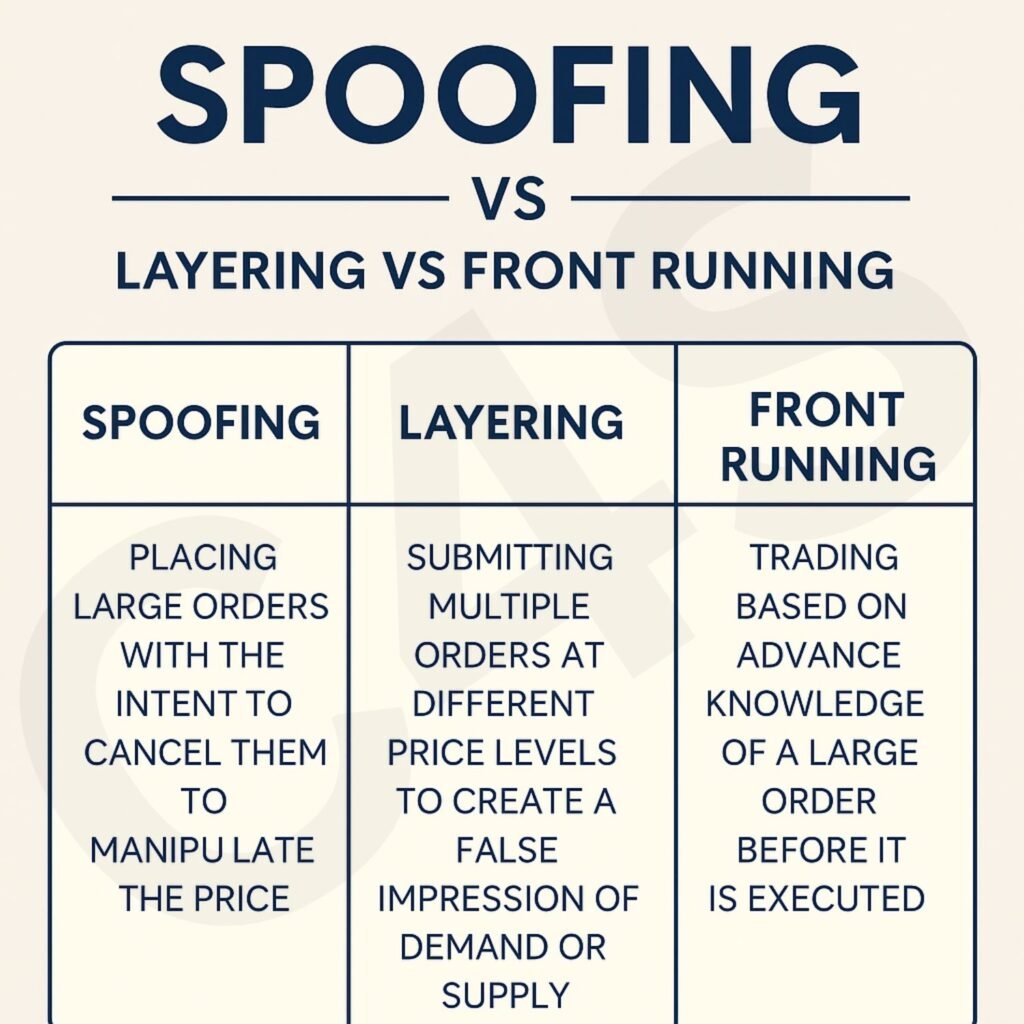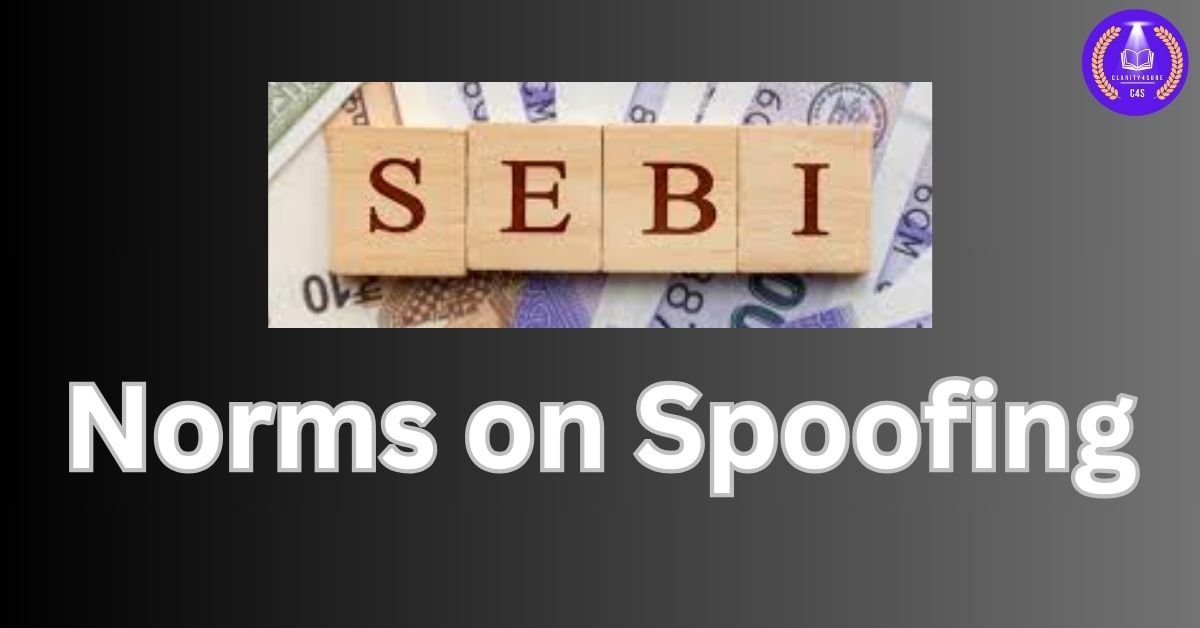Introduction
Spoofing is a market manipulation tactic where traders place large orders with the intent to cancel them before execution. The goal is to create a false sense of demand or supply, influencing asset prices for unfair gain. Recognizing its harmful impact on market integrity, the Securities and Exchange Board of India (SEBI) has developed strict norms and taken enforcement actions against spoofing practices.
What is Spoofing?
Spoofing involves the act of placing orders in the market (typically large orders) without the intention of executing them. These fake orders mislead other market participants about the demand/supply dynamics, artificially influencing prices.
Example:
- A trader places a large buy order for a stock, making it appear in high demand.
- Other participants buy the stock at a higher price.
- The spoofer then cancels the large buy order and sells their own holdings at a profit.

SEBI’s Regulatory Framework Against Spoofing
SEBI has defined spoofing under fraudulent and unfair trade practices (FUTP) and has laid out legal provisions to penalize such acts.
Relevant Legal Provisions:
| Regulation | Description |
|---|---|
| SEBI (Prohibition of Fraudulent and Unfair Trade Practices) Regulations, 2003 | Spoofing is classified under manipulative, fraudulent, and deceptive trade practices under Regulation 3 and 4. |
| SEBI Act, 1992 – Section 11B | Grants SEBI the power to issue directions to prevent market manipulation. |
| SEBI Act – Section 15HA | Imposes monetary penalties for engaging in fraudulent trade practices. |
| Algo Trading Guidelines | SEBI requires controls to detect and prevent spoofing through high-frequency trading algorithms. |
How SEBI Identifies Spoofing ?
SEBI uses a combination of surveillance tools, order book analytics, and data mining to detect spoofing.
Key Indicators:
- High number of order cancellations relative to executed trades.
- Layering of large fake orders away from the best bid/ask.
- Patterns of placing and canceling orders before they hit the price.
Tools Used:
- Integrated Market Surveillance System (IMSS)
- Data Analytics and AI tools
- Stock Exchange Surveillance Systems
Landmark SEBI Cases on Spoofing
1. Axis Securities Case (2023)
- SEBI penalized Axis Securities for failing to monitor clients who engaged in algorithmic spoofing.
- Fine: ₹1 crore
- Violations: Regulation 3(d), 4(1), 4(2)(a), and 4(2)(g) of FUTP.
2. OPG Securities Ltd (NSE Co-Location Case)
- Alleged front-running and spoofing through faster access to order books.
- SEBI barred certain brokers and fined them heavily.
3. Client Code Modification Cases
- Traders used client code modification for creating misleading market movements.
- SEBI flagged such manipulations as spoofing-related.
SEBI’s Preventive Measures Against Spoofing
1. Algo Controls and Pre-Trade Checks
- All algos must be approved by the exchange.
- Exchanges are required to implement order-to-trade ratio caps to prevent excessive cancellations.
2. Penalty for High Cancellation Rates
- SEBI imposes penal charges on orders that are canceled frequently.
3. Direct Market Access (DMA) Restrictions
- SEBI mandates that DMA clients be monitored for suspicious behavior, including spoofing.
4. Behavioral Pattern Surveillance
- Monitoring recurring patterns by specific clients or brokers.
5. Audit Trail Requirement
- Exchanges and brokers must maintain audit trails of every algo and manual order.
Global View: Spoofing Regulations Around the World
| Country | Regulatory Body | Key Regulation |
|---|---|---|
| USA | CFTC / SEC | Dodd-Frank Act, 2010 criminalizes spoofing under Section 747 |
| UK | FCA | Penalizes under Market Abuse Regulation (MAR) |
| EU | ESMA | MIFID II includes spoofing as a form of market abuse |
| Singapore | MAS | Electronic trading regulations prevent order manipulation |
Global Benchmark:
- In 2015, Navinder Singh Sarao, a UK-based trader, was convicted for spoofing that contributed to the 2010 Flash Crash in the US markets.
Penalties for Spoofing in India
| Type of Action | Legal Provision | Maximum Penalty |
|---|---|---|
| Monetary Fine | Section 15HA of SEBI Act | ₹25 crore or 3x the amount of gains, whichever is higher |
| Ban from Trading | Section 11B | Temporary or permanent ban |
| Criminal Proceedings | In serious cases | May include imprisonment |
| Broker Liability | SEBI (Stock Brokers) Regulations | Suspension of license |
Challenges in Regulating Spoofing
| Challenge | Description |
|---|---|
| Real-time Detection | Spoofing happens in milliseconds via algos |
| Proof of Intent | Difficult to prove that the order was not intended for execution |
| Algorithm Complexity | Hard to differentiate between legit strategy and manipulation |
| Cross-border Participation | Offshore traders can spoof in Indian markets using APIs |
| Lack of Investor Awareness | Retail investors are most affected, yet least informed |
Why Spoofing is Harmful ?
- Distorts price discovery
- Creates artificial volatility
- Harms retail and institutional investors
- Undermines trust in the securities market
- Exposes the market to systemic risks through algorithmic abuse
SEBI’s Recent Reforms and Proposed Improvements
1. Instant Trade Suspension Mechanism
Exchanges can suspend suspicious trading activity mid-session.
2. Enhanced Algo Approval
Algo strategies must undergo stricter audit before approval.
3. Dedicated AI Surveillance
SEBI is exploring AI/ML to detect spoofing with greater accuracy.
4. Investor Education Campaigns
Awareness sessions to help investors spot manipulation signs.
Spoofing vs Layering vs Front-Running
| Parameter | Spoofing | Layering | Front-Running |
|---|---|---|---|
| Intent to Execute | ❌ | ❌ | ✅ |
| Order Type | Large single order | Multiple layered orders | Genuine order ahead of clients |
| Legality | Illegal (SEBI) | Illegal (SEBI) | Illegal (SEBI) |
| Manipulation | Yes | Yes | Yes |
| Detection | Surveillance | Deep Book Analysis | Trade-Time Correlation |
Future Outlook
SEBI continues to evolve its regulatory and tech framework to stay ahead of manipulators.
Key Reforms in Pipeline:
- AI Surveillance Grid (ASG):
- Unified surveillance across SEBI, NSE, BSE, MCX, and clearing corporations.
- Uses AI to detect spoofing patterns across instruments.
- Real-Time Public Disclosures:
- Potential to publish spoofing alerts or suspect traders to ensure investor protection.
- Intermediary Grading System:
- Brokers ranked on spoofing incidents, audit lapses, and compliance scores.
- Blockchain-Based Order Audit Logs:
- Immutable audit trails to detect layering/spoofing across time windows.
- Investor Mobile Alerts:
- SEBI considering tools to alert investors of suspicious price movements linked to spoofing.
Conclusion
Spoofing is a sophisticated yet harmful form of market manipulation. Through a combination of surveillance, strict penalties, and global coordination, SEBI is taking active steps to curb spoofing and ensure that Indian financial markets remain fair, transparent, and investor-friendly.
Yet, as technology evolves, SEBI’s vigilance must keep pace. Both regulators and market participants must work in tandem to protect market integrity.
FAQs on Spoofing and SEBI Norms
Is spoofing illegal in India?
Yes. Under SEBI FUTP regulations, spoofing is considered a fraudulent and unfair trade practice.
Can brokers be held liable?
Yes. Brokers must monitor client activity. Failure to prevent spoofing can result in suspension or fines.
How is spoofing different from layering?
Layering is a form of spoofing where multiple fake orders are placed at different price levels.
Are algo traders more prone to spoofing?
Not inherently, but algorithmic trading increases the risk if not properly monitored.
















